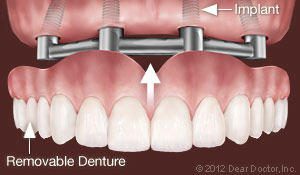General Treatment
It's impossible to overstate the emotional, social and even professional benefits that smiling with confidence can give you. If you find you cover your mouth when you smile, or even hold back your smile because you don't want to show your teeth, you should consider what cosmetic dentistry — the art of smile enhancement — can do for you.

There's so much that can be done these days to improve the appearance of a person's smile — at any age. From powerful, professional whitening treatments to amazingly realistic porcelain veneers to state-of-the-art dental implants, there's a wide range of exciting possibilities.
The first step in any smile makeover is a thorough dental examination to make sure that your cosmetic problems really are just that, and not a sign of underlying dental disease. Once your health has been established, your smile can be cosmetically enhanced in a variety of ways.
Cosmetic Dentistry Procedures
A successful smile makeover is a team effort between you and the dentists who treat you. Depending on which procedures you choose, other highly skilled professionals such as dental lab technicians may also play a crucial role. Some common cosmetic dentistry procedures include:
- Cosmetic Bonding, to repair small chips or cracks (Watch Video)
- Crowns & Bridgework, to replace large amounts of lost tooth structure and/or missing teeth (Watch Video)
- Dental Implants, for the longest-lasting tooth replacement available today (Watch Video)
- Inlays & Onlays, to fill teeth with larger cavities (Watch Video)
- Invisalign Clear Aligners, for highly discreet orthodontic treatment (Watch Video)
- Orthodontic Treatment, to move teeth into the right position (Watch Video)
- Porcelain Veneers, for repairing larger chips and cracks, and reshaping teeth (Watch Video)
- Removable Dentures, to help you smile again (Watch Video)
- Teeth Whitening, to brighten a faded or discolored smile (Watch Video)
- Tooth-Colored Fillings, for a completely natural, healthy look (Watch Video)
Your Smile Makeover
The most important job you have as a member of your own smile makeover team is to communicate exactly what you don't like about your smile and how you'd like it to be different. Before the first consultation, give some thought to the following questions:
- What do you like or dislike about the color, size, shape and spacing of your teeth?
- Are you pleased with how much your teeth show, both when you smile and when your lips are relaxed?
- Do you want teeth that are perfectly aligned and a bright "Hollywood White," or would you prefer a more natural look with slight color, shape and shade variations?
- Would you like more or less of your gums to show when you smile?
It is extremely helpful for you to bring in pictures you have collected — of smiles you like, smiles you don't like, and/or photos of the way your own smile used to look, if that's the result you're aiming for. Now is the time to get started on creating a smile that will make you feel as good as you look!
Related Articles

Cosmetic Dentistry — A Time For Change We are living in an exciting era in dentistry. Today more than ever before, the healing arts are able to provide cosmetic change to meet the public's ever-increasing expectations. Join Dear Doctor magazine as we review the myriad of possibilities available to you for cosmetic dental change... Read Article

The Impact of a Smile Makeover Americans are catching on to the emotional and social importance of a healthy, beautiful smile, and they're seeking out ways to improve their smiles. Learn why, and what a smile makeover could mean for you... Read Article

Beautiful Smiles by Design There's more to the art and science of designing a more appealing smile than you might realize. One of the country's foremost leaders in cosmetic dentistry discusses how you and your dentist can partner to create a great new look... Read Article
Our practice can provide a wide range of dental services. We can typically provide every type of dental service without having to refer you to other specialties. This flexibility saves you time and keeps your total dental care within one practice. Our emphasis is on total preventive care for our patients.
Dental Examination
We will thoroughly examine your teeth and gums, specifically looking for any potential problems. Depending on the patient, X-rays may be taken. If there are any signs of decay or other problems, we will recommend treatment options and make notes of any conditions that may need future observation. Oral hygiene instructions will also be provided along with suggestions to help you care for your teeth.
Routine Teeth Cleanings
Twice a year, you should schedule a routine dental cleaning. During this visit, one of our dental hygienists will remove plaque from your teeth, especially from places where your brush can't reach, such as underneath the gum line and between teeth. We will then clean your teeth and apply fluoride to help protect your teeth once you leave the office.
Fillings
Fillings replace damaged or decayed tooth structure with a restorative material. There are several different types of filling materials, including:
- Silver amalgam: Silver was once the most commonly used material when it came to dental restorations, such as fillings. However, silver fillings do not have much aesthetic appeal to patients.
- Gold fillings: Gold fillings are very durable, able to last approximately 10 to 15 years. The main drawback to gold fillings is the cost of the restoration, since gold is a precious metal.
- White fillings: After much research, some new tooth-colored materials have been developed that are stronger, longer-lasting and more aesthetically pleasing to our patients. These new tooth-colored fillings bond directly to the tooth, strengthening it by restoring most of its original shape. The fillings can even be custom-colored to match your teeth to help give you the most natural-looking smile possible.
Crowns
A crown is a custom-made covering that fits over an original tooth that is either decayed, damaged or cracked. Crowns are made of a variety of different materials such as porcelain, gold, acrylic resin or a mix of these materials.
The treatment plan for a patient receiving a crown usually involves:
- Numbing the tooth to remove the decay in or around it
- Re-sculpturing the tooth to provide an ideal fit for the crown
- Making a physical or digital impression of your teeth in order to create the custom crown
- Making a temporary crown out of acrylic resin and fitting it to the tooth while the custom crown is being made
- Removing the temporary crown and fitting the custom-made one onto the tooth
- Ensuring that the crown has the proper look and fit, and cementing it into place
New technologies have greatly reduced the time needed to make strong, natural-looking crowns. Once the procedure is completed, proper care should be taken to ensure the crown remains in good condition and the teeth and gums are healthy. Given proper care, your crowns can last a lifetime!
Bridges
A bridge is a dental device that fills a space that a tooth previously occupied. A bridge may be necessary to prevent the shifting of teeth, to fix bite problems or to ensure the strength and integrity of the surrounding teeth.
Fixed bridges are the most popular, and consist of a filler tooth attached to two crowns in order to hold the bridge in place. "Maryland" bridges, commonly used to replace missing front teeth, use tooth-colored metal bands bonded to surrounding teeth. And cantilever bridges use two crowned teeth positioned next to each other on the same side of the missing tooth.
Regardless of your needs, we have a bridge solution that will work best!
Root Canals
A root canal is a procedure that extracts decayed tissue from inside a tooth, reshapes the canal and replaces it with strengthened filler. There are a number of reasons a root canal may be necessary, including dental injuries, severe decay and infection or inflammation in the tooth pulp. When left untreated, these problems can cause extensive damage to the tooth structure.
Root canals can typically be completed in one visit, although more extensive cases may require another appointment. You will also be able to drive yourself home after the appointment.
Tooth Extractions
An extraction is the complete removal of a tooth. Extractions are sometimes necessary if:
- A primary tooth is preventing the normal eruption of a permanent tooth
- The tooth has suffered extensive tooth decay or trauma that cannot be repaired
- The patient has gum disease
- The tooth is impacted - this is usually the case with the third molars, or "wisdom teeth," as they erupt years after the other teeth and often have insufficient room in the jaw
Depending on the complexity of the case, an extraction can be performed surgically or non-surgically. A mild anesthesia is used to ensure the patient is as comfortable as possible throughout the procedure.
Of all the ways modern dentistry has to replace missing teeth, dental implants are by far the best. There is no tooth-replacement option that will give you a longer-lasting result. Implants also help preserve tooth-supporting bone that naturally deteriorates when a tooth is lost. Loss of bone is one of the major hidden consequences of losing teeth.

A dental implant most often takes the form of a small, screw-shaped titanium post that replaces the root-part of a missing tooth. The surgical procedure used to place an implant is actually quite minor and routine, requiring only local anesthesia in most cases. After a healing period, the implant is topped with a lifelike crown custom-made to match your existing natural teeth. Implants have a documented success rate of over 95%, which is significantly higher than any other tooth-replacement option.
How Implants Work
During a minor surgical procedure, your dental implant is inserted directly into the jawbone in the space vacated by the missing tooth. It will then be left to heal for a period of months before the final crown is attached. During this healing period, the implant actually fuses to the bone surrounding it.
Tooth Replacement Options Using Dental Implants
Implants can replace missing teeth in a variety of ways. They can be used to:
 Replace One Tooth — When you have one tooth missing, a single implant is inserted into the bone to replace the root part of that tooth; a crown then goes on top to simulate an actual tooth. This treatment choice has the highest success rate, making it the best long-term investment for replacing a single missing tooth. Even if the initial cost is slightly higher than other options, it is the most cost-effective solution over time. An implant will never decay or need root canal treatment, and feels just like the tooth that was there.
Replace One Tooth — When you have one tooth missing, a single implant is inserted into the bone to replace the root part of that tooth; a crown then goes on top to simulate an actual tooth. This treatment choice has the highest success rate, making it the best long-term investment for replacing a single missing tooth. Even if the initial cost is slightly higher than other options, it is the most cost-effective solution over time. An implant will never decay or need root canal treatment, and feels just like the tooth that was there.
 Replace Multiple Teeth — When you have more than one tooth missing, implants provide an ideal replacement mechanism. You don't even need one implant for every missing tooth. Instead, implant teeth can act as supports for fixed bridgework. For example, if you are missing three teeth in a row, we can place two implants, one on either side of the gap, and a crown in between that has no implant underneath. That way, you won't need to use any of your remaining natural teeth as bridge supports, which could weaken them and make them more susceptible to decay.
Replace Multiple Teeth — When you have more than one tooth missing, implants provide an ideal replacement mechanism. You don't even need one implant for every missing tooth. Instead, implant teeth can act as supports for fixed bridgework. For example, if you are missing three teeth in a row, we can place two implants, one on either side of the gap, and a crown in between that has no implant underneath. That way, you won't need to use any of your remaining natural teeth as bridge supports, which could weaken them and make them more susceptible to decay.
 Replace All Teeth Permanently — Implants can support an entire arch of upper or lower replacement teeth that are fixed into the mouth and are never removed. Sometimes the new teeth can be supported by as few as 4 implants. It's comparable to the structure of a table, which only needs 4 legs to hold it up. In cases where jawbone density and volume have deteriorated, 5 or 6 implants might be needed to support a row of 10 to 12 teeth. Dental implant replacement teeth protect your jawbone, won't slip, and should last a lifetime.
Replace All Teeth Permanently — Implants can support an entire arch of upper or lower replacement teeth that are fixed into the mouth and are never removed. Sometimes the new teeth can be supported by as few as 4 implants. It's comparable to the structure of a table, which only needs 4 legs to hold it up. In cases where jawbone density and volume have deteriorated, 5 or 6 implants might be needed to support a row of 10 to 12 teeth. Dental implant replacement teeth protect your jawbone, won't slip, and should last a lifetime.
 Support Removable Dentures — Implants can even make removable dentures more comfortable, effective and healthier to wear. Traditional dentures rest on the gums and put pressure on the underlying bone. This accelerates bone loss so that the jaw shrinks and the dentures slip, particularly on the bottom. But today dentists can attach a removable denture onto implants, transferring that pressure into the bone structure rather than the bone surface. This prevents the dentures from slipping while you eat and speak, and preserves the bone directly beneath them.
Support Removable Dentures — Implants can even make removable dentures more comfortable, effective and healthier to wear. Traditional dentures rest on the gums and put pressure on the underlying bone. This accelerates bone loss so that the jaw shrinks and the dentures slip, particularly on the bottom. But today dentists can attach a removable denture onto implants, transferring that pressure into the bone structure rather than the bone surface. This prevents the dentures from slipping while you eat and speak, and preserves the bone directly beneath them.
Implant Care and Maintenance
There are only two ways an implant can lose attachment to the bone and fail once it has successfully fused: poor oral hygiene or excessive biting forces. Poor oral hygiene and/or a lack of regular cleanings can lead to a destructive bacterial infection called peri-implantitis. Flossing and brushing your teeth on a daily basis, along with regular professional cleanings, can prevent this. Excessive biting forces can come from either a habit of clenching or grinding your teeth, or an insufficient number of implants to handle the forces generated by your bite. You should receive the correct number of implants so this does not happen. And if you have a habit of grinding or clenching your teeth, a nightguard will be recommended to protect your implants. After all, implants are a long-term investment in your smile, your health and your well-being, so it's best to protect your investment.
Related Articles

Dental Implants - Your Best Option For Replacing Teeth Dental implants have many advantages over older methods of tooth replacement like bridges and dentures — from the way they function and feel to the way they look and last. Vigorous research has documented and confirmed that in the right situations, dental implant success rates are over 95%. It is no exaggeration to say that they have revolutionized dentistry. They may even change your life... Read Article

The Hidden Consequences of Losing Teeth For those missing even one tooth, an unsightly gap is actually the least significant problem. What's of far greater concern is the bone loss that inevitably follows tooth loss. Dental implants can preserve bone, improve function and enhance psychological well-being. Learn how implants serve both as anchors to support replacement teeth and preserve bone... Read Article
